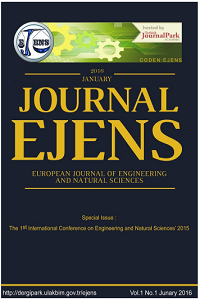Performance of Dual Axis Solar Tracking System Using Fuzzy Logic Control: A Case Study in Pinarhisar, Turkey
Performance of Dual Axis Solar Tracking System Using Fuzzy Logic Control: A Case Study in Pinarhisar, Turkey
___
- [1]. V. Khare, S.Nema, and P.Baredar,“Status of solar wind renewable energy in India,” Renewable and Sustainable Energy Reviews, vol. 27, pp. 1–10, Nov.2013
- [2]. V. Subramanian, “Renewable energy in India: status and future prospects,” Ministry of New and Renewable Energy, 2007
- [3]. S. K. Sahoo, “Renewable and sustainable energy reviews solar photovoltaic energy progress in India: A review,” Renewable and Sustainable Energy Reviews, vol. 59, pp. 927–939, June.2016
- [4]. (2016) The teias website. [Online]. Available: http:// www.teias.gov.tr/yukdagitim/kuruluguc
- [5]. S. Sun, J. Brooks, T. Nguyen, A. Harding, D. Wang, and T. David, “Novel Organic and Polymeric Materials for Solar Energy,” Energy Procedia, vol.57, pp.79 – 88, 2014.
- [6]. P. Oelhafen and A. Schuler, “Nanostructured materials for solar energy conversion,” Solar Energy, vol.79, pp.110–121, August. 2005.
- [7]. R. Pradhan and B. Subudhi, “Design and real-time implementation of a new auto-tuned adaptive MPPT control for a photovoltaic system,” Electrical Power and Energy Systems, vol. 64, pp.792–80, 2015.
- [8]. S. Daraban, D. Petreus, and C. Morel, “A novel MPPT (maximum power point tracking) algorithm based on a modified genetic algorithm specialized on tracking the global maximum power point in photovoltaic systems affected by partial shading,” Energy, vol.74, pp.374-388, Sep.2014.
- [9]. I. Stamatescu, I. Făgărășan, G. Stamatescu, N. Arghira, and S.S. Iliescu, “Design and Implementation of a Solar-Tracking Algorithm,” Procedia Engineering, vol.9, pp. 500-507, 2014.
- [10]. İ. Sefa, M. Demirtas, and İ. Çolak, “Application of one-axis sun tracking system, Energy Conversion and Management, vol. 50, pp. 2709–2718 Nov. 2009.
- Başlangıç: 2015
- Yayıncı: CNR Çevre
Diagnosis of Coronary Artery Disease Using Deep Belief Networks
Process Design for the Recycling Of Tetra Pak Components
PSIM Simulation of Flyback Converter for P&O and IC MPPT Algorithms
Biodiesel Production Using Wet and Dry Purification Methods
Nonlinear Buckling Analysis of Cold-Formed Channel Sections
Prediction of Dam Reservoir Volume Fluctuations Using Adaptive Neuro Fuzzy Approach
